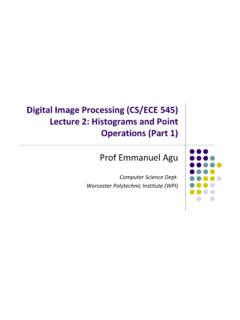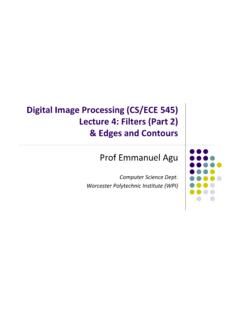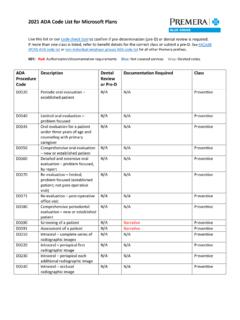Transcription of Digital Image Processing (CS/ECE 545) Introduction to ...
1 Digital Image Processing (CS/ECE 545) Lecture 1: Introduction to Image Processing and ImageJProf Emmanuel AguComputer Science Polytechnic Institute (WPI)What is an Image ? 2 dimensional matrix of Intensity (gray or color) valuesSet of Intensity valuesImage coordinatesare integersExample of Digital Imagesa)Natural landscapeb)Synthetically generated scenec)Poster graphicd)Computer screenshote)Black and white illustrationf)Barcodeg)Fingerprinth)X rayi)Microscope slidej)Satellite Imagek)Radar imagel)Astronomical objectImaging SystemCredits: Gonzales and WoodsExample: a cameraConverts light to imageDigital Image ? Remember: digitizationcauses a Digital Image to become an approximationof a real scene1 pixelImages taken from Gonzalez & Woods, Digital Image Processing (2002)Real imageDigital Image (an approximation)Real imageDigital Image (an approximation) Digital Image Common Image formats include: 1 values per point/pixel (B&W or Grayscale) 3 values per point/pixel (Red, Green, and Blue) 4 values per point/pixel (Red, Green, Blue, + Alpha or Opacity) We will start with gray scale images, extend to color laterGrayscaleRGBRGBAWhat is Image Processing ?
2 Algorithms that alter an input Image to create new Image Input is Image , output is Image Improves an Image for human interpretation in ways including: Image display and printing Image editting Image enhancement Image compressionOriginal ImageProcessed ImageImage Processing Algorithm( Sobel Filter)Example Operation: Noise RemovalThink of noise as white specks on a picture (random or non-random)Examples: Noise RemovalImages taken from Gonzalez & Woods, Digital Image Processing (2002)Example: Contrast AdjustmentExample: Edge DetectionExample: Region Detection, SegmentationExample: Image CompressionExample: Image InpaintingInpainting? Reconstruct corrupted/destroyed parts of an imageExamples: Artistic (Movie Special )EffectsApplications of Image Processing ddApplications of Image Processing ddApplications of Image Processing : MedicineOriginal MRI Image of a Dog HeartEdge Detection ImageImages taken from Gonzalez & Woods, Digital Image Processing (2002)Applications of Image Processing ddApplications of Image Processing : Geographic Information Systems (GIS) Terrain classification Meteorology (weather)Images taken from Gonzalez & Woods, Digital Image Processing (2002)Applications of Image Processing : Law Enforcement Number plate recognition for speed cameras or automated toll systems Fingerprint recognitionImages taken from Gonzalez & Woods, Digital Image Processing (2002)Applications of Image Processing .
3 HCI Face recognition Gesture recognitionRelationship with other FieldsKey Stages in Digital Image ProcessingImage AcquisitionImage RestorationMorphological ProcessingSegmentationObject recognitionImage EnhancementRepresentation & DescriptionProblem DomainColour Image ProcessingImage CompressionKey Stages in Digital Image Processing : Image AquisitionImage AcquisitionImage RestorationMorphological ProcessingSegmentationObject recognitionImage EnhancementRepresentation & DescriptionProblem DomainColour Image ProcessingImage CompressionImages taken from Gonzalez & Woods, Digital Image Processing (2002)Example: Take a pictureKey Stages in Digital Image Processing : Image EnhancementImage AcquisitionImage RestorationMorphological ProcessingSegmentationObject recognitionImage EnhancementRepresentation & DescriptionProblem DomainColour Image ProcessingImage CompressionImages taken from Gonzalez & Woods, Digital Image Processing (2002)Example: Change contrastKey Stages in Digital Image Processing : Image RestorationImage AcquisitionImage RestorationMorphological ProcessingSegmentationObject recognitionImage EnhancementRepresentation & DescriptionProblem DomainColour Image ProcessingImage CompressionImages taken from Gonzalez & Woods, Digital Image Processing (2002)Example: RemoveNoiseKey Stages in Digital Image Processing .
4 Morphological ProcessingImage AcquisitionImage RestorationMorphological ProcessingSegmentationObject recognitionImage EnhancementRepresentation & DescriptionProblem DomainColour Image ProcessingImage CompressionImages taken from Gonzalez & Woods, Digital Image Processing (2002)Extract attributesuseful for describingimageKey Stages in Digital Image Processing :SegmentationImage AcquisitionImage RestorationMorphological ProcessingSegmentationObject recognitionImage EnhancementRepresentation & DescriptionProblem DomainColour Image ProcessingImage CompressionImages taken from Gonzalez & Woods, Digital Image Processing (2002)Divide Image into constituent partsKey Stages in Digital Image Processing :Object RecognitionImage AcquisitionImage RestorationMorphological ProcessingSegmentationObject recognitionImage EnhancementRepresentation & DescriptionProblem DomainColour Image ProcessingImage CompressionImages taken from Gonzalez & Woods, Digital Image Processing (2002) Image regions transformed suitable for computer processingKey Stages in Digital Image Processing :Representation & DescriptionImage AcquisitionImage RestorationMorphological ProcessingSegmentationObject recognitionImage EnhancementRepresentation & DescriptionProblem DomainColour Image ProcessingImage CompressionImages taken from Gonzalez & Woods, Digital Image Processing (2002)Finds & Labels objects in scene ( motorbike)Key Stages in Digital Image Processing .
5 Image CompressionImage AcquisitionImage RestorationMorphological ProcessingSegmentationObject recognitionImage EnhancementRepresentation & DescriptionProblem DomainColour Image ProcessingImage CompressionReduceimage size( JPEG)Key Stages in Digital Image Processing :Colour Image ProcessingImage AcquisitionImage RestorationMorphological ProcessingSegmentationObject recognitionImage EnhancementRepresentation & DescriptionProblem DomainColour Image ProcessingImage CompressionConsider color images (color models, etc)Mathematics for Image Processing Calculus Linear algebra Probability and statistics Differential Equations (PDEs and ODEs) Differential Geometry Harmonic Analysis (Fourier, wavelet, etc)About This Course Image Processing has many aspects Computer Scientists/Engineers develop tools ( photoshop) Requiresknowledge of maths, algorithms, programming Artistsuse Image Processing tools to modify pictures DOES NOT require knowledge of maths, algorithms, programmingExample: Portraiture photoshop pluginExample.
6 Knoll Light Factory photoshop pluginExample: ToonItphotoshop pluginAbout This Course Most hobbyists follow artist path. Not much math! This Course: Image Processing for computer scientists and Engineers!!! Teaches concepts, uses ImageJ as concrete example ImageJ: Image Processing library Includes lots of already working algorithms, Can be extended by programming new Image Processing techniques Course is NOT just about programming ImageJ a comprehensive course in ImageJ. (Only parts of ImageJ covered) about using packages like Photoshop, GIMPA bout This Course Class is concerned with: How to implement Image Processing algorithms Underlying mathematics Underlying algorithms This course is a lot of work. Requires: Lots of programming in Java (maybe some MATLAB) Lots of math, linear systems, fourier analysisAdministrivia: Syllabus Summary 2 Exams (50%), 5 Projects (50%) Projects: Develop ImageJ Java code on any platform but must work in Zoolab machine May discuss projects but turn in individual projects Class website: ~emmanuel/courses/cs545/S14/ Text: Digital Image Processing : An Algorithmic Introduction using Javaby Wilhelm Burger and Mark J.
7 Burge, Springer Verlag, 2008 Cheating: Immediate F in the course My advice: Come to class Read the text Understand concepts before codingLight And The Electromagnetic Spectrum Light: just a particular part of electromagnetic spectrum that can be sensed by the human eye The electromagnetic spectrum is split up according to the wavelengths of different forms of energyReflected Light The colours humans perceive are determined by nature of light reflected from an object For example, if white light(contains all wavelengths) is shone onto green object it absorbs most wavelengths absorbed except green wavelength (color)Colours AbsorbedElectromagnetic Spectrum and IP Images can be made from any form of EM radiationImages from Different EM Radiation Radar imaging (radio waves) Magnetic Resonance Imaging (MRI) (Radio waves)
8 Microwave imaging Infrared imaging Photographs Ultraviolet imaging telescopes X rays and Computed tomography Positron emission tomography (gamma rays) ultrasound (not EM waves)Human Visual System: Structure Of The Human Eye The lens focuses light from objects onto the retina Retina covered with light receptors called cones(6 7 million) androds(75 150 million) Cones concentrated around fovea. Very sensitive to colour Rods more spread out and sensitive to low illumination levelsImages taken from Gonzalez & Woods, Digital Image Processing (2002) Image Formation In The Eye Muscles in eye can change the shape of the lens allowing us focus on near or far objects An Image is focused onto retina exciting the rods and cones and send signals to the brainImage Formation The Pinhole Camera (abstraction) First described by ancient Chinese and Greeks (300 400AD)
9 Thin LensBrightness Adaptation & Discrimination The human visual system can perceive approximately 1010different light intensity levels However, at any one time we can only discriminate between a much smaller number brightness adaptation Similarly, perceived intensityof a region is related to the light intensities of the regions surrounding itBrightness Adaptation & Discrimination: Mach Band EffectImages taken from Gonzalez & Woods, Digital Image Processing (2002)Perceived intensityovershoots or undershootsat areas of intensity changeBrightness Adaptation & DiscriminationAn example of simultaneous contrastImages taken from Gonzalez & Woods, Digital Image Processing (2002)All inner squares have same intensity but appear darker as outersquare (surrounding area) gets lighterImage Acquisition Images typically generated by illuminatinga sceneand absorbing energy reflected by scene objects Images taken from Gonzalez & Woods, Digital Image Processing (2002) Image Sensing Incoming energy ( light)
10 Lands on a sensor material responsive to that type of energy, generating a voltage Collections of sensors are arranged to capture imagesImaging SensorLine of Image SensorsArray of Image SensorsImages taken from Gonzalez & Woods, Digital Image Processing (2002)Spatial Sampling Cannot record Image values for all (x,y) Sample/record Image values at discrete (x,y) Sensors arranged in grid to sample imageImage (Spatial) Sampling A Digital sensor can only measure a limited number of samplesat a discreteset of energy levels Samplingcan be thought of as:Continuous signal x comb function Quantization:process of converting continuous analogsignal into its Digital representation Discretize Image I(u,v)values Limit values Image can takeImage QuantizationImage Sampling And Quantization Sampling and quantization generates approximationof a real world sceneImages taken from Gonzalez & Woods, Digital Image Processing (2002) Image as Discrete FunctionImage as a FunctionRepresenting Images Image data structure is 2D array of pixel values Pixel values are gray levels in range 0 255 or RGB colors Array values can be any data type (bit, byte, int, float, double, etc.)
















